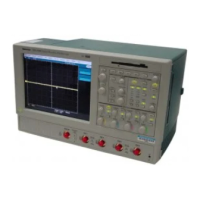Do you have a question about the Tektronix TDS1000 Series and is the answer not in the manual?
| Sample Rate | Up to 1 GS/s |
|---|---|
| Math Functions | Add, Subtract, Multiply, Divide, FFT |
| Channels | 2 |
| Memory Depth | 2.5k points |
| Display | 5.7 inch |
| Display Type | Color or Monochrome LCD |
| Vertical Resolution | 8-bit |
| Trigger Modes | Edge, Video |
| Connectivity | USB |
| Input Impedance | 1 MΩ |
Essential safety precautions to prevent injury and product damage, including fire and electrical shock hazards.
Explains warning and caution terms and common safety symbols found on the product.
Instructions for installing the oscilloscope, including power cord and security loop usage.
A quick procedure to verify the oscilloscope's basic operational status after setup.
Guide to verify probe operation, compensation, and attenuation settings for accurate measurements.
Routine to optimize the oscilloscope's signal path for maximum measurement accuracy.
Covers essential functions like Autoset, saving, and recalling setups for effective operation.
Explains trigger principles, types, modes, source, coupling, slope, and level for stable displays.
Details signal acquisition modes (Sample, Peak Detect, Average) and time base settings.
How to adjust waveform display size and location using vertical and horizontal controls.
Covers measurement methods using graticule, cursors, and automatic measurement features.
Explains the various elements and readouts displayed on the oscilloscope screen.
Details the functions of vertical knobs and buttons for waveform adjustment.
Explains horizontal knobs and buttons for time base and position adjustment.
Describes controls for setting up trigger level, holdoff, and trigger modes.
Identifies and explains the purpose of various input and output connectors on the oscilloscope.
Step-by-step guide to quickly display and measure signal frequency and amplitude using Autoset.
Using time cursors to accurately measure the duration of a pulse waveform.
Techniques for analyzing noisy signals using Peak Detect and averaging.
Procedure for capturing and optimizing the acquisition of non-repeating events.
How to use video triggering for stable display of video signals.
Detailed technical specifications for the oscilloscope's performance and features.
Technical specifications and compliance information for the P2200 probe.











